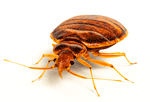(720)990-5566
Learning Center: Bed Bugs 101

Quick Facts About Bed Bugs:
-
A female, once fertilized can lay between 3-4 eggs per day which adds up to 300-500 in her lifetime.
-
At room temperature, within 14 days the eggs will hatch into nymphs
-
From egg to adult is approximately 6-8 weeks.
-
Bed bugs shed their skin 5 times (molt) as they mature and reach adulthood
-
Between each molt, they need a blood meal
-
The lifespan of an adult is between 10-12 months
-
After feeding they return back to their hiding place, they do not remain on humans. So, if there is an infestation, they may attach to your clothing and be transported.
-
Typical bite marks are from the multiple bites they take when they are feeding which can form in clusters or a line.
-
Bed bugs are carriers of up to 27 varying pathogens like HIV or Hep. B. Thankfully, there has never been any documented evidence of the diseases from bugs to humans, but there is risk of infection. Scratching the bites may cause them to infect. In some extreme cases, anemia has been caused by bed bugs.
These adult wingless parasites are about the size of an apple seed and rust in color. As juveniles they are clear, although if they have recently fed, they are bright red. They are barely noticeable to the human eye being only slightly over 1mm in size.
They don't have nests and they don’t fly unlike other pests, sadly, they move quickly and thrive in groups wherever they are able to find a hiding place.
Like fleas, they are blood-feeding insects and prefer human blood to anything else. If human hosts are unavailable, they will prey on small rodents, house pets and other animals. Although the marks that their bites leave, they are not known for spreading diseases. For some, sleeplessness and psychological distress can occur due to anxiety about being bitten.
Bed bugs are hitchhikers and attach themselves in people’s bags, clothing and furniture when they move, traveling from one place to another.
For decades, America was free from widespread infestations and they only occurred in places like Asia.
With the great number of people traveling around the world nowadays, bed bugs are moving from country to country by those vacation makers staying in hotels, which is why infestations are so prevalent. It’s not just hotels that can be affected, bed bugs can also be transferred into your home on your clothing and bedding if you move.
Plush surfaces and wooden floors are just two of the things which bed bugs are partial to. So, they love headboards, bed frames, nooks and crannies and seams in your mattress. Your carpet would also be an oasis for bed bugs. They don’t usually move too far away from their host, which means they are more than likely to be present in your sleeping area/bedroom. Much larger infestations will move entirely through a house and every surface.
When we are asleep is the time when bed bugs are most active. Crawling onto any exposed skin and injecting a mild anesthetic, then suck a tiny amount of blood. The only way that people know they have been bitten is from the welts, rash, bumps which form on the skin the following morning.
While their hosts sleep easy, and during the early hours of the morning, the bed bugs feed, but only for between 5-10 minutes. If there is low light, and they are still hungry, they will feed in daylight hours. When they have finished feeding they will crawl back into their sheltered area and digest their meal which can take several days.
The typical lifespan for a bed bug is between 10-12 months, during that time, it is possible for a female to lay between 300-55 eggs. This does however depend on the available food and temperature of the room. After the female has laid her eggs, 10 days later they hatch (under ideal conditions), and then 5-8 weeks later, the nymphs can mature to adulthood.
Sadly, for all warm-blooded creatures, bed bugs are very resilient. An infant can survive for many months without feeding, whereas an adult can survive for 1 year without food.
They are extremely resilient pests, and can fight against most chemicals, so merely throwing away any bed parts or furniture that is infested, won’t solve the problem. Infestations of bed bugs is not something to ignore, you should employ the services of a Professional Exterminator whenever there is an infestion.








